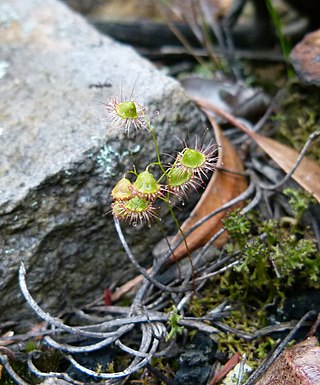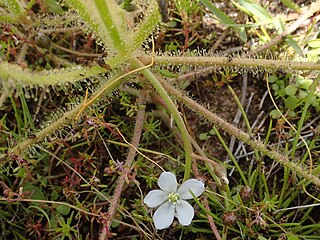
Drosera stolonifera, sometimes referred to as the leafy sundew, is a tuberous perennial species in the genus Drosera that is endemic to Western Australia. It produces 2 to 3 semi-erect lateral stems that grow 10 to 15 cm long. It is most closely related to D. purpurascens, but differs by several characteristics including height and petiole length. It is native to a number of swampy locations around Perth south to Pinjarra. It grows in peaty water-logged soils in swamp heathland and flowers from September to October. After a bushfire it will flower en masse.

Drosera dielsiana is a compact rosetted sundew native to South Africa, Eswatini (Swaziland), Mozambique, Malawi, and Zimbabwe. It was described as a new species by Arthur Wallis Exell and Jack Rodney Laundon in 1956. The diploid chromosome number is 2n=40. It was named in honor of Ludwig Diels, the author of the 1906 monograph on the Droseraceae.

Drosera sect. Erythrorhiza is a section of 14 species of tuberous species in the genus Drosera. It represents a natural group of all the rosetted tuberous Drosera. Most species are endemic to Western Australia, but D. aberrans, D. praefolia, D. schmutzii, and D. whittakeri are also found in eastern Australia.

Drosera andersoniana, the sturdy sundew, is an erect perennial tuberous species in the genus Drosera that is endemic to Western Australia. It produces a basal rosette of leaves similar to that of D. peltata and the stem grows to 8–25 cm (3–10 in). Its pink-white to red flowers emerge from August to September. D. andersoniana grows in loamy soils near granite outcrops.

Drosera bicolor is an erect perennial tuberous species in the genus Drosera that is endemic to Western Australia. It produces a basal rosette of leaves similar to that of D. peltata and the stem grows to 11 cm (4 in) high. Its white flowers that have a red spot near the petal base emerge from September to October. D. bicolor grows in deep silica sand on heathland along the upper Phillips River and south-east of Lake King.

Drosera graniticola is an erect perennial tuberous species in the carnivorous plant genus Drosera that is endemic to Western Australia. It grows 10–20 cm (4–8 in) high near granite outcrops. White flowers emerge from August to September.

Drosera heterophylla, the swamp rainbow, is an erect perennial tuberous species in the carnivorous plant genus Drosera that is endemic to Western Australia. It grows in shallow water swamps or wet clay flats near granite outcrops and occurs in the vicinity of Perth and to its north. D. heterophylla produces small leaves along an erect stem that can be 10–30 cm (4–12 in) tall. It is the only species in the genus that produces many-petaled flowers. These white flowers emerge from June to September.

Drosera huegelii, the bold sundew, is an erect perennial tuberous species in the carnivorous plant genus Drosera that is endemic to Western Australia. It grows in sandy soils in winter-wet depressions and margins of swamps and occurs along the south-west coast of Australia. D. huegelii produces small, bell-shaped leaves along an erect stem that can be 10–50 cm (4–20 in) tall. White to cream-coloured flowers emerge from June to September.
Drosera intricata is a scrambling or climbing perennial tuberous species in the carnivorous plant genus Drosera that is endemic to Western Australia. It grows in clay-sand soils on swamp margins, or other habitats that are seasonally wet. D. intricata produces small carnivorous leaves along a glabrous stem that can be 25–40 cm (10–16 in) tall. Its 3-12 yellow flowers emerge from September to October. It gains its species name, intricata, from its twining or winding habit.

Drosera menziesii, the pink rainbow, is an erect or scrambling perennial tuberous species in the carnivorous plant genus Drosera. It is endemic to Western Australia and grows in a variety of habitats, including winter-wet depressions, swamps, and granite outcrops in clay or peat sand soils or loam. D. menziesii produces small, circular carnivorous leaves along an undulating erect stem that can be .05–1.1 m (0.2–3.6 ft) high. Its pink flowers emerge from July to November.

Drosera glanduligera, commonly known as the pimpernel sundew or scarlet sundew, is a species of carnivorous plant endemic to southern Australia. It is an ephemeral annual plant that grows in the winter and flowers from August to November.

Drosera subg. Lasiocephala, sometimes collectively known as the petiolaris-complex, is a subgenus of 14 species in the genus Drosera. These species are distinguished by their subpeltate to peltate lamina.

Drosera lanata is a carnivorous plant in the genus Drosera and is endemic to the Northern Territory and Queensland in Australia. Its leaves are arranged in a compact basal rosette. Narrow linear petioles less than 2 mm wide emerge from the center of the rosette and hold carnivorous leaves at the end. Both petioles and the center of the rosette are densely covered in silvery dendritic hairs. These dendritic hairs afford the plant insulation and allow it to trap morning dew for additional moisture during the dry season. The leaf lamina is maroon-red and 2 mm long by 2.5 mm wide.

Drosera trinervia is a species in the carnivorous plant genus Drosera that is endemic to the Cape Provinces of South Africa. It was first described by Kurt Polycarp Joachim Sprengel in his 1820 work Neue Entdeckungen im ganzen Umfang der Pflanzenkunde.
Drosera villosa is a species of sundew native to south-east Brazil. It was originally described by Augustin Saint-Hilaire in 1826.

Drosera finlaysoniana is a carnivorous herb found in Australia and south east Asia. More commonly found in the north of Australia. In southern Australian sites it has been recorded at inland areas, in eucalyptus woodlands subject to flooding. Also found in Hainan, Taiwan, the Indo-China region and the Philippines.

Drosera citrina is a pygmy sundew, a type of carnivorous plant. It is native to Western Australia. The Latin specific epithet citrina means "lemon coloured", referring to the colour of the flowers. It is closely related to Drosera nivea, which was considered a variety of D. citrina in the past called Drosera citrina var. nivea
Drosera nivea is a species of carnivorous plant. It is a pygmy sundew and is native to Western Australia. The specific epithet nivea is derived from the Latin word niveus, meaning white, in reference to the colour of the plant's flower. It is closely related to Drosera citrina and has previously been considered a variety of D.citrina known as D. citrina var. nivea.
Drosera latifolia is a species of sundew native to southern and south-eastern Brazil. It was first described as Drosera villosa var. latifolia by August Wilhelm Eichler in 1872, and elevated to species by Paulo Gonella and Fernando Rivadavia in 2014.
Drosera amazonica is a species of sundew native to northern Brazil. It was first described by Fernando Rivadavia, Andreas Fleischmann and Maria Vicent in 2009.















